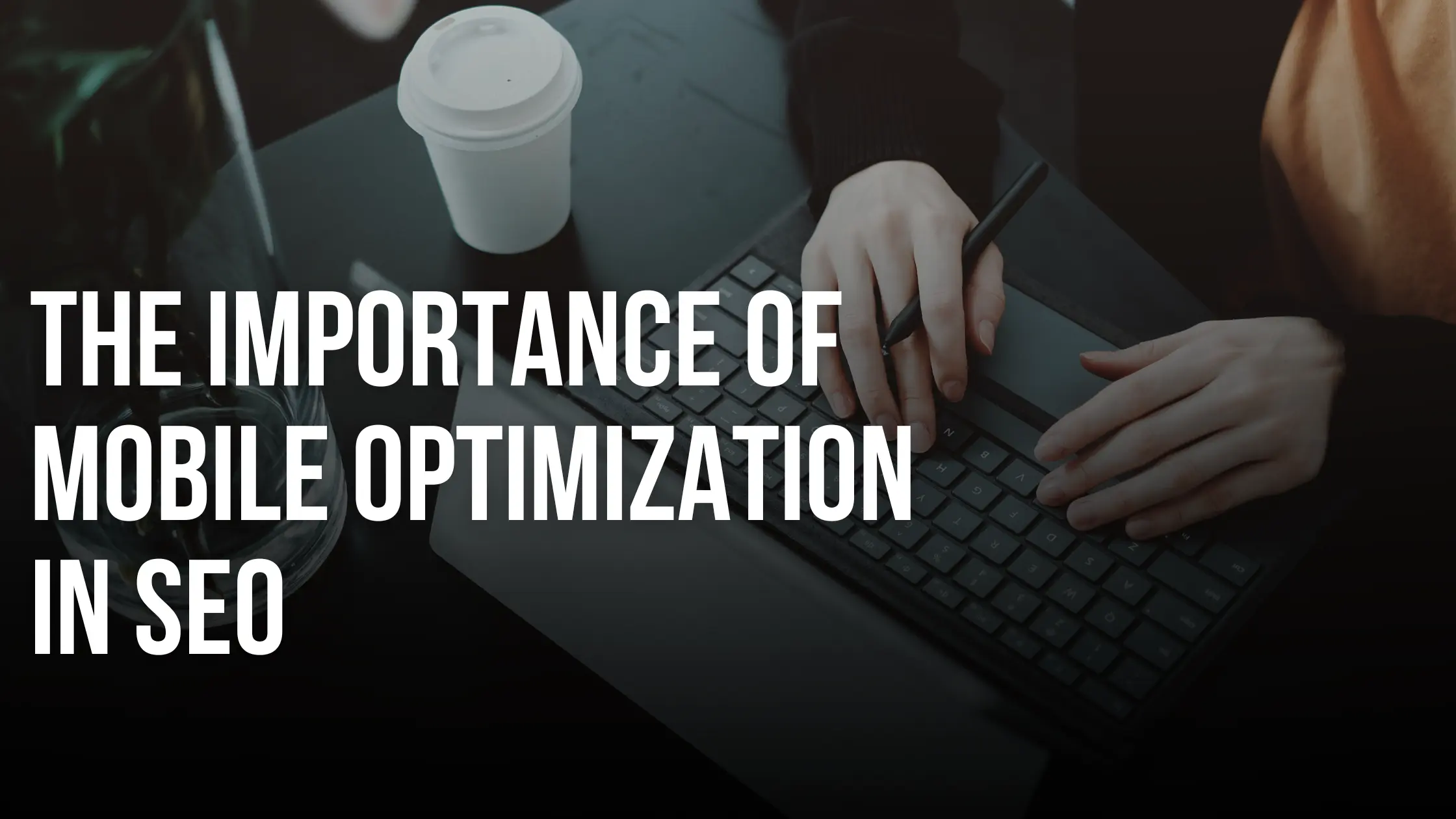In today’s digital era, mobile devices have become an extension of our daily lives. Whether it’s shopping online, reading news, watching videos, or checking emails, most users now rely on their smartphones and tablets for internet access. According to recent studies, over 60% of all web traffic comes from mobile devices. This seismic shift in user behavior has significantly influenced the way websites are designed, developed, and optimized. For businesses, marketers, and SEO professionals, mobile optimization is no longer optional—it is a necessity. Thus importance of mobile optimization get increases.
Search engines like Google have already made their stance clear by rolling out mobile-first indexing, which means that Google predominantly uses the mobile version of the content for indexing and ranking. If your website is not optimized for mobile devices, you risk losing both rankings and valuable traffic. In this blog, we will explore what mobile optimization is, why it’s crucial for SEO, the process involved in optimizing a website for mobile, how it impacts your website’s visibility on AI-driven platforms, and the tools and plugins that can simplify the task.
Table of Contents
- What is Mobile Optimization?
- Importance of Mobile Optimization
- The Process of Mobile Optimization
- How Mobile Optimization Helps Rank Your Website in AI Tools
- Plugins and Tools for Mobile Optimization
- Conclusion
What is Mobile Optimization?
Mobile optimization is the process of ensuring that visitors who access your website from mobile devices have an experience that is just as smooth and user-friendly as the desktop version. This includes everything from responsive web design and fast-loading pages to touch-friendly navigation and properly formatted content.
In essence, mobile optimization is about designing your website so that it automatically adjusts to various screen sizes and operating systems. This process includes optimizing images, minimizing code, enhancing UI/UX, and making sure all elements work perfectly across different devices.

Importance of Mobile Optimization
- Growing Mobile Usage: As mentioned earlier, the majority of web traffic now originates from mobile devices. Ignoring mobile users means alienating a large portion of your potential audience.
- Google’s Mobile-First Indexing: Since Google predominantly uses the mobile version of a website for indexing and ranking, a non-optimized site can severely impact your SEO performance.
- Improved User Experience: A mobile-optimized site ensures that users can navigate easily, find information quickly, and complete desired actions like filling out forms or making purchases without frustration.
- Faster Load Times: Mobile optimization involves practices that significantly reduce loading times, which is a critical factor for both user satisfaction and search engine rankings.
- Higher Conversion Rates: A smooth and intuitive mobile experience can directly impact your conversion rates. Users are more likely to stay and convert if they don’t have to struggle with layout or functionality.
- Reduced Bounce Rates: If a site is difficult to use on mobile, users are likely to leave quickly, which increases bounce rates and negatively affects your SEO rankings.
The Process of Mobile Optimization
- Responsive Web Design: This is the cornerstone of mobile optimization. A responsive site automatically adapts to different screen sizes and orientations. Use fluid grids, flexible images, and media queries to build responsive layouts.
- Mobile-Friendly Navigation: Simplify menus and navigation structures. Use large, easy-to-tap buttons and collapsible menus to improve usability.
- Optimize Images and Media: Compress images without losing quality. Use modern formats like WebP, and consider lazy loading for faster performance.
- Minimize Load Time: Use caching, minify CSS/JS files, and eliminate render-blocking resources. Consider using a Content Delivery Network (CDN).
- Readable Fonts and Layouts: Ensure that fonts are legible on small screens. Avoid using small font sizes or overcrowded layouts.
- Avoid Flash: Most mobile browsers don’t support Flash. Stick to HTML5 and other modern technologies.
- Test and Monitor Performance: Use tools like Google Mobile-Friendly Test, PageSpeed Insights, and Search Console to test and monitor mobile performance.
How Mobile Optimization Helps Rank Your Website in AI Tools
Artificial Intelligence (AI) tools like ChatGPT, Google Gemini, and Microsoft Copilot are becoming increasingly important in how users discover and interact with content. These tools scrape, analyze, and summarize web content to provide accurate answers. Here’s how mobile optimization supports AI-based visibility:
- Structured Data: Mobile-optimized sites often include structured data markup, making it easier for AI to understand and retrieve information.
- Faster Crawling and Indexing: A well-optimized mobile site allows search engine bots to crawl and index content more efficiently, which also benefits AI tools that depend on updated data.
- Improved Accessibility: Mobile-friendly sites are usually more accessible, meaning AI tools can interpret the content easily and display it correctly in voice search or AI-based summaries.
- Lower Bounce Rate and Better Engagement: AI algorithms favor content that engages users. A mobile-optimized site tends to have better engagement metrics.
- Enhanced Voice Search Compatibility: Since voice search is frequently done on mobile devices, optimization ensures your content ranks higher in voice results.
Plugins and Tools for Mobile Optimization
- WPtouch: This WordPress plugin automatically enables a simple and elegant mobile theme for mobile visitors. It helps maintain fast-loading mobile pages.
- AMP (Accelerated Mobile Pages): Google-backed framework that enables lightning-fast mobile pages. Ideal for blogs and news sites.
- Smush: Image compression plugin that optimizes all images without compromising quality, crucial for mobile loading speed.
- LiteSpeed Cache: This all-in-one site acceleration plugin includes server-level cache and optimization features.
- Autoptimize: Optimizes HTML, CSS, and JavaScript code. Helps improve mobile page load speed.
- Elementor: A drag-and-drop page builder that includes mobile editing tools. It allows you to design mobile-specific versions of pages.
- Jetpack: Offers a suite of performance tools including lazy loading and content delivery optimization.
- Google Site Kit: Provides essential metrics from Google Analytics, Search Console, and PageSpeed Insights in your WordPress dashboard.
Book a Free Consultation with Websync Media📞 Call us at +91-8777703476 |
Conclusion
Mobile optimization is no longer a choice but a critical necessity for SEO success. If your website isn’t delivering a seamless experience on mobile devices, you are missing out on traffic, engagement, and conversions. From improved visibility in Google and AI tools to higher user satisfaction, the benefits are far-reaching.
At Websync Media, we specialize in crafting mobile-optimized websites that not only look stunning but also perform flawlessly. Whether you want a fresh redesign or an audit of your current site, our team of experts is ready to help.
- Content Marketing in 2025: From Blogs to Video to Interactive Tools - November 6, 2025
- Instagram vs Pinterest: Where Should a Company Focus for Branding? - October 30, 2025
- How to Choose Between Organic vs Paid Advertising for Your Business - October 22, 2025





